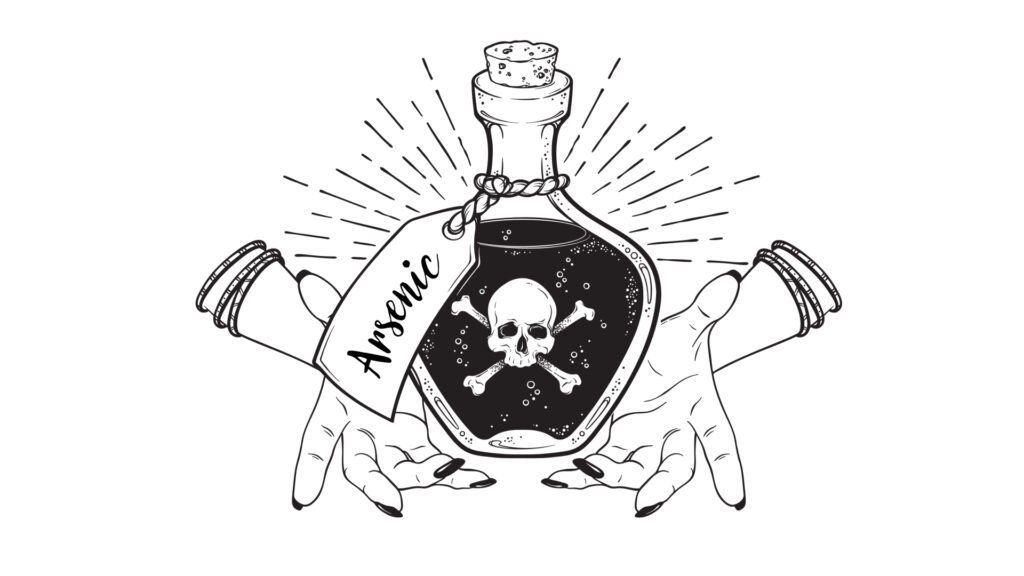Water, water, every where,
And all the boards did shrink;
Water, water, every where,
Nor any drop to drink.
– Samuel Taylor Coleridge (1772-1834), The Rime of the Ancient Mariner
The 22nd of March is World Water Day, and we decided to talk about an old enemy that unfortunately all too often is associated with water, arsenic. Called by the Greeks “the king of poisons”, for its ability to be lethal and at the same time odourless and colourless in water, contamination of drinking water by arsenic still affects 220 million people worldwide. But, if you think it’s just a problem in Bangladesh, read on.
An old Italian favourite
It was the year 1587. Francesco I De Medici, Grand Duke of Tuscany, and his wife, Bianca Cappello, died at their Tuscan villa in Poggio a Caiano, near Florence, after a sudden, violent and unknown illness. Their illness occurred – mysteriously – immediately after the arrival at the villa of Francesco’s brother, Ferdinando, who, according to rumors, had very good reasons to hope for Francesco’s death.
The Grand Duke and his wife died within hours of each other, with very similar symptoms. Such symptoms included persistent vomiting, gastric burns, extreme dehydration and delirium. Suspiciously, Ferdinando closed the case quickly, asking for a rapid autopsy to be sure to “exclude hypotheses of poisoning.” It was the 16th century and they didn’t have a spectrometer to analyze trace elements, so the autopsy simply stated that the bodies of the deceased showed “obvious gastric inflammation, enlarged liver, multiple hematomas in the lungs and extensive edema.” In 2006, however, a forensic toxicology study put the case back on track. All the clues collected by the chronicles of the time indicated that Francesco was killed by arsenic poisoning, at the time aristocracy’s preferred poison for getting rid of inconvenient brothers, unwanted daughters-in-law and illegitimate children. The study analyzed tissue samples taken from the femur of the couple, and reported levels of arsenic between 5 and 10 mg/kg for him and between 4 and 6 for her. Concentrations of arsenic above 10 mg/kg are classified as chronic poisoning (you die slowly), above 45 mg/kg as lethal poisoning (you die immediately), while values below 1 mg/kg are considered normal. The Grand Duke of Tuscany and his wife were probably poisoned by his brother Ferdinando with an acute dose of arsenic, low enough to keep them alive 11 days and look like a disease, but still designed to be lethal.
Arsenic today
Traces of arsenic are found virtually in every rock. It is usually found in pyrite and other iron oxides or hydroxidesThe arsenic in rocks and sediments is contained in iron sulphide (pyrite) and in iron oxide and hydroxide, and it can be released relatively easily by processes occurring in aquifer waters. It is classified as a Group I carcinogen by the Agency for Research on Cancer because long-term exposure to doses over 100 μg/L (“μg/L” is read as microgram per liter) can lead to skin, lung, and bladder cancer, as well as other nefarious effects not directly carcinogenic such as respiratory and cardiovascular problems and severe neurological damage in childhood.
But is it all dangerous? We asked Ron Fuge, Professor Emeritus of Environmental Geochemistry and Medical Geology at Aberystwyth University in the United Kingdom. “Arsenic in aquifer waters occurs in two forms arsenite (AsO33-) and arsenate (AsO43-). In surface waters and shallow aquifers, where the water is in contact with the atmosphere, arsenate is dominant, while in deep groundwaters, cut off from the atmosphere, arsenite is the dominant form. While both forms of arsenic are toxic, arsenite has been found to be at least 10 times more toxic. Unfortunately, the recommended maximum content of arsenic in drinking water takes no account of the form of arsenic.”
The limit value for arsenic in the European Union is 10 μg/L, as it is in the United States. However, some countries are stricter. Denmark has a limit of 5 μg/L, and the Netherlands of 1 μg/L. On the other hand, India, China, and Bangladesh have a limit of 50 μg/L (in the absence of other water sources, otherwise it’s 10 for them too). A 2020 study by Science showed that up to 220 million people today are exposed to possible arsenic poisoning, 94% of which concentrated in Asia. Arsenic accumulates most readily in young alluvial sediments and river basins, and thus areas such as Bangladesh, Pakistan, Vietnam and Cambodia are naturally more exposed to the issue. Nevertheless, the study shows that Italy is not immune to the risk of arsenic poisoning. While Italy’s average concentration is within the 10 ug/L limit, many European countries exceed this, including Spain, Hungary, Greece and Romania, which have average concentrations well above the maximum limit. In italy though, there are few “hot spots”where, due to the geological conditions, the concentration of arsenic is higher. These hotspots include Tuscany, southern Sardinia and the lower Po Valley.
In Lombardy, drinking water is analysed by the Health System, which monitors the quality of water intended for human consumption. Milan’s drinking water is judged pure and without any health hazard from both chemical and microbiological points of view, but data on arsenic is not easy to find. A 2019 report for the metropolitan city of Milan shows that arsenic is not routinely measured except in some areas, which reportedly showed arsenic values above the 10 ug/L cut off. When arsenic is over the limit, Prof. Fuge explains, “normal treatment processes for drinking waters, filtration and disinfection, will not remove it from solution. The most common process used to treat arsenic-rich waters is to pass the water through a bed of iron oxide, arsenic is adsorbed onto the surface of the iron oxide.”
The news that there is arsenic in the Po plain doesn’t come as a surprise The environmental agency’s groundwater data revealed that about ¼ of underground water bodies show arsenic concentrations over the limit (out of 421 stations, 124 show arsenic between 11 and 70 μg/L, with a peak of 294 μg/L in one station), and a report on chemical status reveals that 68% of underground water bodies are in a “NOT GOOD” status, due to high levels of arsenic, ammonium and trichloromethane (chloroform). The Lombardy Water Protection Plan (two 400-page long reports and 190 MB of technical documents) nevertheless says that “the hydrostructures used for drinking water purposes take into account the water bodies that have within them exclusively groundwater monitoring points with ”GOOD” status”. So let’s all breathe a sigh of relief.
With increasing demands for groundwater, as cities expand and farming intensifies, and as climate may drive changes in our water supplies, in areas like northern Italy we cannot afford to take our eye off the ball. Unless, that is, you were intent on eliminating your father-in-law by poisoning him, then your plan B may be delivered to you in its own time…
Over The Pop
Erin Brockovich | The quintessential David vs. Goliath film, it’s the true story of Erin Brockovich, the woman with no legal training who sparked the case against petrochemical company Pacific Gas & Electric, which was found guilty of contaminating the groundwater in the town of Hinckley, California, with hexavalent chromium. The film brings Julia Roberts in a state of grace (she won the Oscar for Best Actress in a leading role) and a great screenplay. If you don’t like it you have a heart of stone and bad taste in clothes.
Bad Waters | Also inspired by a true story, the film tells of a series of communities between Ohio and Virginia and their 20-year battle against the chemical giant DuPont, guilty of poisoning the waters with an uncontrolled spill of perfluorooctanoic acid. Mark Ruffalo as the lawyer is a plus (though not as top as Julia Roberts).
Last but not least, for the curious out there here is an interactive site on water quality in the USA -bad news if you live in Nebraska or in certain areas of Texas-, and here the one for the UK).
 This article appeared for the first time on our fortnightly newsletter. To keep up with the scientific debate, join the community of Monnalisa Bytes and to receive a preview of all our newsletters subscribe here!
This article appeared for the first time on our fortnightly newsletter. To keep up with the scientific debate, join the community of Monnalisa Bytes and to receive a preview of all our newsletters subscribe here!
